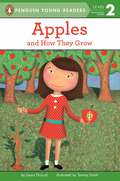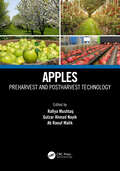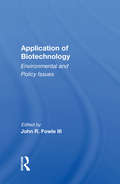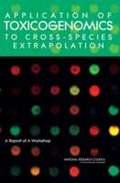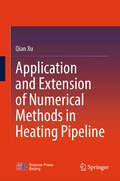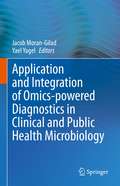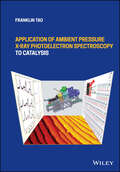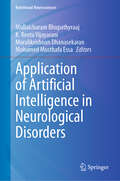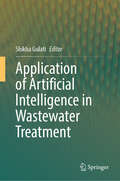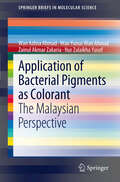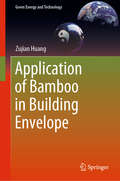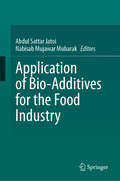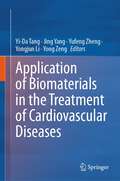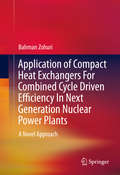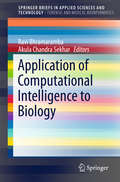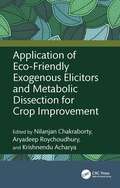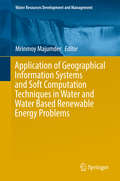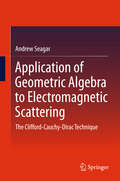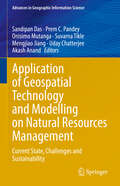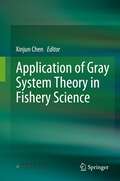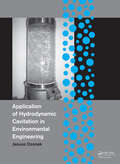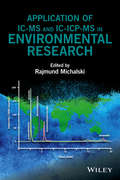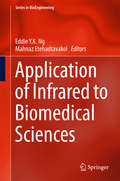- Table View
- List View
Appetite and Its Discontents: Science, Medicine, and the Urge to Eat, 1750-1950
by Elizabeth A. WilliamsWhy do we eat? Is it instinct? Despite the necessity of food, anxieties about what and how to eat are widespread and persistent. In Appetite and Its Discontents, Elizabeth A. Williams explores contemporary worries about eating through the lens of science and medicine to show us how appetite—once a matter of personal inclination—became an object of science. Williams charts the history of inquiry into appetite between 1750 and 1950, as scientific and medical concepts of appetite shifted alongside developments in physiology, natural history, psychology, and ethology. She shows how, in the eighteenth century, trust in appetite was undermined when researchers who investigated ingestion and digestion began claiming that science alone could say which ways of eating were healthy and which were not. She goes on to trace nineteenth- and twentieth-century conflicts over the nature of appetite between mechanists and vitalists, experimentalists and bedside physicians, and localists and holists, illuminating struggles that have never been resolved. By exploring the core disciplines in investigations in appetite and eating, Williams reframes the way we think about food, nutrition, and the nature of health itself..
Appetite and Its Discontents: Science, Medicine, and the Urge to Eat, 1750-1950
by Elizabeth A. WilliamsWhy do we eat? Is it instinct? Despite the necessity of food, anxieties about what and how to eat are widespread and persistent. In Appetite and Its Discontents, Elizabeth A. Williams explores contemporary worries about eating through the lens of science and medicine to show us how appetite—once a matter of personal inclination—became an object of science. Williams charts the history of inquiry into appetite between 1750 and 1950, as scientific and medical concepts of appetite shifted alongside developments in physiology, natural history, psychology, and ethology. She shows how, in the eighteenth century, trust in appetite was undermined when researchers who investigated ingestion and digestion began claiming that science alone could say which ways of eating were healthy and which were not. She goes on to trace nineteenth- and twentieth-century conflicts over the nature of appetite between mechanists and vitalists, experimentalists and bedside physicians, and localists and holists, illuminating struggles that have never been resolved. By exploring the core disciplines in investigations in appetite and eating, Williams reframes the way we think about food, nutrition, and the nature of health itself..
Apples: And How They Grow (Penguin Young Readers, Level 2)
by Laura DriscollLearn all about how a seed turns into an apple in this informative nonfiction reader.
Apples: Preharvest and Postharvest Technology
by Gulzar Ahmad Nayik Rafiya Mushtaq Ab Raouf MalikDue to polymorphism, apples have extraordinary diversity. Depending on variety, apple fruits can differ in color, shade or size; apples even can be oval or pear-shaped. There are more than 10,000 varieties of apple, which vary in taste, shape, juiciness, texture, color, firmness and other qualities. For these reasons, apples have been diversely studied, and many improvements have been made such as the introduction of high density cropping; rootstock breeding; or varietal development. Therefore it is important to understand and document the production methods adopted and implemented in recent times for harvesting maximum benefits of the crop. Apples: Preharvest and Postharvest Technology documents production practices along with detailed illustration on varieties, rootstocks, important cultural practices and post-harvest management. This book will serve as a complete guide for apple production from farm to fork and will help students, scholars, researchers and scientists working in this domain. The book will also help growers all over the world to understand best practices for apple production, to harvest maximum yields, and in turn, to increase their returns.
Application Of Biotechnology: Environmental And Policy Issues
by John R. FowleThis book provides the technical background and a historical perspective of biotechnology. It examines scientific questions on the assessment of risk for the release of genetically engineered organisms into the environment and describes the role of individuals to foster industrial growth.
Application Of Toxicogenomics To Cross-species Extrapolation
by National Research Council of the National AcademiesSome of what we know about the health effects of exposure to chemicals from food, drugs, and the environment come from studies of occupational, inadvertent, or accident-related exposures. When there is not enough human data, scientists rely on animal data to assess risk from chemical exposure and make health and safety decisions. However, humans and animals can respond differently to chemicals, including the types of adverse effects experienced and the dosages at which they occur. Scientists in the field of toxicogenomics are using new technologies to study the effects of chemicals. For example, in response to a particular chemical exposure, they can study gene expression ("transcriptomics"), proteins ("proteomics") and metabolites ("metabolomics"), and they can also look at how individual and species differences in the underlying DNA sequence itself can result in different responses to the environment. Based on a workshop held in August 2004, this report explores how toxicogenomics could enhance scientists' ability to make connections between data from experimental animal studies and human health.
Application and Extension of Numerical Methods in Heating Pipeline
by Qian XuThis book is a summary of the author's pioneering work on the theory of heating pipelines and its application expansion over the years, trying to establish a complete logical system from the basic theory of pipelines to the application of heating pipelines to the innovation and expansion of large-diameter energy transmission pipelines. These esoteric fundamental theories are linked to practical applications, and numerical simulations are used to help readers understand the problems faced by pipelines in engineering practice. The book consists of four chapters, the first chapter describes the basic concepts of district heating system, related standards, development history, facing problems and future prospects, while for the basic characteristics of district heating pipe network installation and laying methods made an introduction; followed by the second chapter summarizes and organizes the pipeline safety research of fluid-solid heat, elastic-plasticity and other basic theories, as well as heating pipeline thermal insulation system heat loss and the economic evaluation of theory and so on. Based on the basic theory of pipeline, the third and fourth chapters introduce several typical pipeline application cases in detail, and each case includes modelling, solving, and result analysis, which can provide readers with technical references and idea guidelines in the field of pipeline research. The third chapter of the different structures of the heating pipeline from the safety and economic aspects of a detailed numerical study; the fourth chapter in the heating pipeline on the basis of energy transportation pipeline, transportation medium from the original hot water, hot steam to the oil and gas, specifically introduced various types of large-diameter energy transportation pipeline under the action of different loads of the dynamic response characteristics. It has important theoretical significance for enriching and developing the basic theory of pipeline and the expansion of all kinds of pipeline applications, and at the same time, it provides technical guidance for the safe, stable, economic and efficient operation of all kinds of long-distance pipelines, such as heating pipelines and energy transmission and transportation pipelines. It helps readers to systematically and comprehensively understand the basic theories of elasticity and plasticity, fluid-solid-thermal coupling, and economic evaluation of pipelines, and at the same time provides readers with new research ideas and technical means from the perspective of scientific research.
Application and Integration of Omics-powered Diagnostics in Clinical and Public Health Microbiology
by Jacob Moran-Gilad Yael YagelVarious “omics” methods have recently revolutionized molecular diagnostics. Next-generation sequencing (NGS) makes it possible to sequence a human genome in just one day. Whole genome sequencing (WGS) greatly improves the ability to investigate the outbreaks of numerous pathogens. Metagenomics helps to analyze the microbiome, which aids greatly in identifying the pathogenesis of infectious diseases. Proteomic-based methods, namely matrix-assisted laser desorption-ionization time of flight mass spectrometry (MALDI-TOF-MS), have a promising role in identifying myctobacteria and fungi, and predicting antimicrobial resistance. While there are numerous scientific publications on “omics” applications for microbiology, there are relatively few books that review this topic from a clinical diagnostics perspective. This book looks at this field from a holistic viewpoint, instead of limiting by type of “omics” technology, in order to cover the body of knowledge needed for practitioners and academics interested in clinical and public health microbiology. Additionally, it addresses the management, economical, regulatory and operational aspects of integrating these technologies into routine diagnostics.
Application of Ambient Pressure X-ray Photoelectron Spectroscopy to Catalysis
by Franklin TaoAPPLICATION OF AMBIENT PRESSURE X-RAY PHOTOELECTRON SPECTROSCOPY TO CATALYSIS Authoritative and detailed reference on ambient-pressure x-ray photoelectron spectroscopy for practitioners and researchers starting in the field Application of Ambient Pressure X-ray Photoelectron Spectroscopy to Catalysis introduces a relatively new analytical method and its applications to chemistry, energy, environmental, and materials sciences, particularly the field of heterogeneous catalysis, covering its background and historical development, its principles, the instrumentation required to use it, analysis of data collected with it, and the challenges it faces. The features of this method are described early in the text; the starting chapters provide a base for understanding how AP-XPS tracks crucial information in terms of the surface of a catalyst during catalysis. The second half of this book delves into the specific applications of AP-XPS to fundamental studies of different catalytic reactions. In later chapters, the focus is on how AP-XPS could provide key information toward understanding catalytic mechanisms. To aid in reader comprehension, the takeaways of each chapter are underlined. In Application of Ambient Pressure X-ray Photoelectron Spectroscopy to Catalysis, readers can expect to find detailed information on specific topics such as: Going from surface of model catalyst in UHV to surface of nanoparticle catalyst during catalysis Application of XPS from surface in UHV to surface in gas or liquid phase and fundamentals of X-ray spectroscopy Significance and challenges of studying surface of a catalyst in gaseous phase and instrumentation of ambient pressure X-ray photoelectron spectrometers Experimental methods of AP-XPS studies and difference in data analysis between AP-XPS and high vacuum XPS Ambient Pressure X-Ray Photoelectron Spectroscopy is an ideal resource for entry level researchers and students involved in x-ray photoelectron spectroscopy. Additionally, the text will appeal to scientists in more senior roles in academic and government laboratory institutions in the fields of chemistry, chemical engineering, energy science, and materials science.
Application of Artificial Intelligence in Neurological Disorders (Nutritional Neurosciences)
by Muralikrishnan Dhanasekaran Mullaicharam Bhupathyraaj K. Reeta Vijayarani Mohamed Musthafa EssaThis book discusses the role of artificial intelligence in neurological disorders, including, alleviating movement disorders, psychiatric disorders, diagnosis of neurological and neurodegenerative disorders, dementia, neuronal cancer, neuronal Infections, and brain diseases. It explores applications of artificial intelligence in the early diagnosis, prognosis, and development of new therapies against neurodegenerative disorders. This book also provides cutting-edge research using AI for studying neuroimage analysis, toward the discovery of new biological pathways and systems implicated in dementia and related diseases. It also reviews AI-based interventions in depression research and treatment. The chapter also examines the potential benefits of using AI to help manage depression, from improved access to coordinated care. This book is an essential source for students, researchers, academicians, and neurologists aiming to understand AI-based approaches for the diagnosis, treatment, and prevention of neurological disorders.
Application of Artificial Intelligence in Wastewater Treatment
by Shikha GulatiThis book offers a comprehensive exploration of the integration of artificial intelligence (AI) techniques in addressing challenges and optimizing processes within wastewater treatment. The coverage of the book spans a spectrum of applications, including AI-driven monitoring and control systems, predictive modeling for pollutant removal, and the development of smart sensor networks for real-time data analysis in wastewater treatment plants. By amalgamating AI methodologies with wastewater treatment processes, the book provides insights into enhancing efficiency, reducing costs, and mitigating environmental impacts. In the current research scenario, the theme of the book is highly pertinent as it responds to the pressing need for sustainable and efficient wastewater treatment solutions. The book defines the theme by elucidating how AI technologies, such as machine learning algorithms and data analytics, can revolutionize wastewater treatment processes by enabling proactive decision-making, optimizing resource allocation, and predicting potential system failures. This intersection of AI and wastewater treatment not only addresses operational challenges but also contributes to the broader goal of achieving environmentally conscious and economically viable solutions.
Application of Bacterial Pigments as Colorant: The Malaysian Perspective (SpringerBriefs in Molecular Science)
by Wan Yunus Wan Ahmad Wan Azlina Ahmad Zainul Akmar Zakaria Nur Zulaikha YusofEnvironmental concerns regarding continuous use of synthetic dyes saw a revival in the demand for natural dyes as natural dyes exhibit better biodegradability and generally have a higher compatibility with the environment. However, one of the limitations on the use of natural dyes or pigments is the low extraction yield factors (a few grams of pigment per kg of dried raw material). Therefore, the exploitation of other biological sources such as fungi, bacteria and cell cultures offers interesting alternative. Microbial pigments such as from bacterial origins offer the advantage in terms of production compared to pigments extracted from vegetables or animals, due to its simple cell and fast culturing technique. This book offers interesting insight into initial works carried out to demonstrate the potential use of bacterial pigment as colorant for various applications.
Application of Bamboo in Building Envelope (Green Energy and Technology)
by Zujian HuangThis book offers a comprehensive overview of the use of bamboo in building industry. It systematically demonstrates bamboo’s utility in terms of its properties, describing the material properties of typical industrial bamboo products, and discussing their performance evaluation and optimization as building components and in the creation of building envelopes. The book also includes examples of the high-value utilization of bamboo forest resources. Further, it examines how building performance may be affected by conditions such as climate. Including insights from material science, construction design, building physics and building climatology, the book also provides data obtained from technology and market status investigation, laboratory test and the computer simulation.This book appeals to scientists and professionals, as it introduces and tests various bamboo products, demonstrating the advantages and disadvantages for each one. The book is also a valuable resource for civil engineers and students interested in this unique plant material and its application in the building industry.
Application of Bio-Additives for the Food Industry
by Nabisab Mujawar Mubarak Abdul Sattar JatoiThis text provides advanced and comprehensive information related to food additives based on bio-sources. A thorough overview of the many groups of microorganisms used as food additives is presented, as well as all of their main characteristics. The chapters give a step-by-step description of bio based food additives, including substances that are employed commercially by manufacturers as enzymes, antioxidants, stabilizers, emulsifiers, organic acids, colorants, sweeteners, and flavorings. Additionally, each chapter places a focus on the usage of probiotics and enzymes as examples of microbes used as medicinal agents. In its examination of the food additive lists for food products for the manufacture of nourishing and safe food, Application of Bio-Additives for the Food Industry offers a thorough, updated overview of food bio-additives that can be utilized by food scientists, nutritionists, microbiologists and more.
Application of Biomaterials in the Treatment of Cardiovascular Diseases
by Yong Zeng Yufeng Zheng Jing Yang Yi-Da Tang Yongjun LiThis book summarizes the recent advancements for biomaterials in the field of cardiovascular disease, including drug delivery system (gene, protein, drug), implant interventional instrument (heart valve, heart blocker, stent, artificial blood vessel, patch, artificial heart, cardiac pacemaker, etc.) have been innovated and applied to the clinical uses to treatment of cardiovascular disease. Through the summary of this book, readers will have comprehensive and advanced understanding of the application of biomaterials in the field of cardiovascular disease.
Application of Compact Heat Exchangers For Combined Cycle Driven Efficiency In Next Generation Nuclear Power Plants: A Novel Approach
by Bahman ZohuriCovers the fundamentals of combined-cycle plants to provide background for understanding the progressive design approaches at the heart of the text Discusses the types of compact heat exchanger surfaces, suggesting novel designs that can be considered for optimal cost effectiveness and maximum energy production Undertakes the thermal analysis of these compact heat exchangers throughout the life cycle, from the design perspective through operational and safety assurance stages This book describes the quest to create novel designs for compact heat exchangers in support of emergent combined cycle nuclear plants. The text opens with a concise explanation of the fundamentals of combined cycles, describing their efficiency impacts on electrical power generation systems. It then covers the implementation of these principles in nuclear reactor power systems, focusing on the role of compact heat exchangers in the combined cycle loop and applying them to the challenges facing actual nuclear power systems. The various types of compact heat exchanger surfaces and designs are given thorough consideration before the author turns his attention to discussing current and projected reactor systems, and how the novel design of these compact heat e xchangers can be applied to innovative designs, operation and safety analyses to optimize thermal efficiency. The book is written at an undergraduate level, but will be useful to practicing engineers and scientists as well.
Application of Computational Intelligence to Biology (SpringerBriefs in Applied Sciences and Technology)
by Ravi Bhramaramba Akula Chandra SekharThis book is a contribution of translational and allied research to the proceedings of the International Conference on Computational Intelligence and Soft Computing. It explains how various computational intelligence techniques can be applied to investigate various biological problems. It is a good read for Research Scholars, Engineers, Medical Doctors and Bioinformatics researchers.
Application of Eco-Friendly Exogenous Elicitors and Metabolic Dissection for Crop Improvement
by Aryadeep Roychoudhury Krishnendu Acharya Nilanjan ChakrabortyDue to the alarming increase in human population and global food demand, farmers are looking for a better option that can provide them huge benefits within a short period of time. The use of chemical pesticides, fungicides, or other chemical fertilizers altogether causes a huge adverse impact on the environment. Using environmentally safe elicitor molecules can solve this problem in two ways. First, their application is a cost-effective process, which can provide maximum benefit to the farmers. Second, they are safe to apply directly to the environment.Key features of the book:1) It covers a vast area of research undertaken on elicitation processes.2) It comprises both biotic and abiotic stress tolerance through elicitation.3) It highlights a low-cost technology for adoption in future for larger benefits for a better future.4) Omics approaches are highlighted.5) The chapters are supported by sufficient illustrations.This book comprises aspects of elicitation or elicitor-mediated research undertaken so far, to provide a direction toward a chemical-hazard-free world without compromising the yield and market value of the plant-based products. This book aims to guide students at the undergraduate and postgraduate levels as well as researchers, academicians and other industry professionals.
Application of Geographical Information Systems and Soft Computation Techniques in Water and Water Based Renewable Energy Problems (Water Resources Development and Management)
by Mrinmoy MajumderThis book highlights the application of Geographical Information System (GIS) and nature based algorithms to solve the problems of water and water based renewable energy resources. The irregularity in availability of resources and inefficiency in utilization of the available resources has reduced the potentiality of water and water based renewable energy resources. In recent years various soft computation methods (SCM) along with GIS were adopted to solve critical problems. The book collects various studies where many SCMs were used along with GIS to provide a solution for optimal utilization of natural resources for satisfying the basic needs of the population as well as fulfilling their burgeoning energy demands. The articles depict innovative application of soft computation techniques to identify the root cause and to mitigate the uncertainty for optimal utilization of the available water resources. The advantage of SCM and GIS were used to maximize the utilization of water resources under cost and time constraints in face of climatic abnormalities and effect of rapid urbanization.
Application of Geometric Algebra to Electromagnetic Scattering: The Clifford-Cauchy-Dirac Technique
by Andrew SeagarThis work presents the Clifford-Cauchy-Dirac (CCD) technique for solving problems involving the scattering of electromagnetic radiation from materials of all kinds. It allows anyone who is interested to master techniques that lead to simpler and more efficient solutions to problems of electromagnetic scattering than are currently in use. The technique is formulated in terms of the Cauchy kernel, single integrals, Clifford algebra and a whole-field approach. This is in contrast to many conventional techniques that are formulated in terms of Green's functions, double integrals, vector calculus and the combined field integral equation (CFIE). Whereas these conventional techniques lead to an implementation using the method of moments (MoM), the CCD technique is implemented as alternating projections onto convex sets in a Banach space. The ultimate outcome is an integral formulation that lends itself to a more direct and efficient solution than conventionally is the case, and applies without exception to all types of materials. On any particular machine, it results in either a faster solution for a given problem or the ability to solve problems of greater complexity. The Clifford-Cauchy-Dirac technique offers very real and significant advantages in uniformity, complexity, speed, storage, stability, consistency and accuracy.
Application of Geospatial Technology and Modelling on Natural Resources Management: Current State, Challenges and Sustainability (Advances in Geographic Information Science)
by Prem C. Pandey Uday Chatterjee Sandipan Das Onisimo Mutanga Suvarna Tikle Mengjiao Jiang Akash AnandThis contributed volume provides coverage of geospatial technology and modelling techniques that are useful for natural resource assessment at various scales, from regional to global. This makes it a valuable resource for researchers, practitioners, scientists, faculties and students interested in understanding how geospatial tools can be used to assess natural resources. The book provides numerous examples of how geospatial technology and modeling can be applied to different natural resource management scenarios, including forest management, wildlife conservation, water resources management, and climate change adaptation. The book takes an interdisciplinary approach to natural resource management, bringing together perspectives from ecology, environment, geography, geology, and other fields.
Application of Gray System Theory in Fishery Science
by Xinjun ChenThis book reviews the gray system and combines its latest research results in fishery science. The chapters cover the basic concept and theory of gray system, original data processing and gray sequence generation, gray correlation analysis, gray cluster analysis, gray system modeling, gray prediction, gray decision-making, and gray linear programming. The theory of gray system is a new cross-sectional discipline founded in 1982 by Professor Deng Julong, a well-known scholar in China. In recent decades, it has not only been deepened and expanded in theory but also widely used in the fields of society, economy, ocean, agriculture, fishery, and other fields, and made a series of significant scientific achievements. These have laid the foundation for the important position of the gray system theory. Due to the great uncertainty of the fishery resources and the fishery environment involved in the fishery science system, which is completely different from the natural resources on the land, the data and information belong to the category of “poor information”, and the variability and uncertainty are greater than other natural resources. As an extremely effective analytical method and tool, gray system theory has been applied increasingly in fishery science. The book is developed based on well-read and practical literature and will help scientists and research units engaged in scientific research and teaching in fishery science and related fields to develop new research methods and tools.
Application of Hydrodynamic Cavitation in Environmental Engineering
by Janusz OzonekContaining the state-of-the-art in hydrodynamic cavitation, the book consists of two parts. The first part presents the physical basis of cavitation and a systematic classification of various kinds of cavitation and their formation sources. Special attention is paid to a group of factors that promote cavitation formation in natural liquids. A gener
Application of IC-MS and IC-ICP-MS in Environmental Research
by Rajmund MichalskiIntroduces the reader to the field of ion chromatography, species analysis and hyphenated methods IC-MS and IC-ICP-MS including the theory and theirs applications Covers the importance of species analysis and hyphenated methods in ion chromatography Includes practical applications of IC-MS and IC-ICP-MS in environmental analysis Details sample preparation methods for ion chromatography Discusses hyphenated methods IC-MS and IC-ICP-MS used in determining both the total element contents and its elements Details speciation analysis used in studying biochemical cycles of selected chemical compounds; determining toxicity and ecotoxicity of elements; food and pharmaceuticals quality control; and in technological process control and clinical analytics
Application of Infrared to Biomedical Sciences (Series in BioEngineering)
by Eddie Y. K. Ng Mahnaz EtehadtavakolThe book covers the latest updates in the application of infrared to biomedical sciences, a non-invasive, contactless, safe and easy approach imaging of skin and tissue temperatures. Its diagnostic procedure allows practitioners to identify the locations of abnormal chemical and blood vessel activity such as angiogenesis in body tissue. Its non-invasive approach works by applying the technology of the infrared camera and state-of-the-art software, where high-resolution digital infrared imaging technology benefits highly from enhanced image production, standardized image interpretation protocols, computerized comparison and storage, and sophisticated image enhancement and analysis. The book contains contributions from global prominent scientists in the area of infrared applications in biomedical studies. The target audience includes academics, practitioners, clinicians and students working in the area of infrared imaging in biomedicine.

